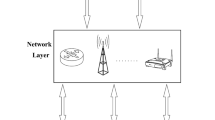Abstract
The optimum deployment of sensors to provide the highest rate of environmental coverage in wireless sensor networks is one of the most important challenges in these types of networks. Apart from the analysis of data, the impact of an intrusion detection system on the performance of system is in a direct relation with the amount of collected data by sensors. Thus, proper deployment of the data collection sensors in intrusion detection systems is quite an important issue. In this article, we consider the subject of optimizing the coverage for wireless sensor networks without infrastructures by using wireless intrusion detection sensors. Due to the efficiency of wireless networks without infrastructures in inner and outer environments, both of these environments are considered in the simulations. Moreover, some of effective parameters in installation the sensors, such as existence of connecting chains between the sensors for transferring collected data, preferred areas for coverage, along with negative effects in distribution of wireless waves like environmental obstacles, the signal strength after weakening and the minimum receiving potentials in the original receiver are considered in simulations. In such situations, a real-world environment and actual conditions are provided in covering and deployment of the sensors. Simulations are done by MATLAB and the covering rates are given both numerically and graphically as the outcomes of each experiment. The results indicate the proper deployment of the sensors and obtaining the most rates in environmental covering by the sensors with regards to the applied limitations.









Similar content being viewed by others
References
Yick, J., Mukherjee, B., & Ghosal, D. (2008). Wireless sensor network survey. Computer Networks, 52(12), 2292–2330.
Mandal, P. S., & Ghosh, A. K. (2011). Secure position verification for wireless sensor networks in noisy channels. In International conference on Ad-Hoc networks and wireless (pp. 150–163). Berlin: Springer.
Strikos, A. A. (2007). A full approach for intrusion detection in wireless sensor networks. School of Information and Communication Technology, KTH.
Bhattasali, T., & Chaki, R. (2011). A survey of recent intrusion detection systems for wireless sensor network. In International conference on network security and applications (pp. 268–280). Berlin: Springer.
Albers, P., Camp, O., Percher, J. M., Jouga, B., Me, L., & Puttini, R. S. (2002). Security in Ad Hoc networks: A general intrusion detection architecture enhancing trust based approaches. In Proceedings of the first international workshop on wireless information systems (WIS-2002) (pp. 1–12).
Sun, B., Wu, K., & Pooch, U. W. (2003). Alert aggregation in mobile ad hoc networks. In 2nd ACM workshop on wireless security (pp. 69–78). ACM.
Hutchison, K. (2005). Wireless intrusion detection systems. SANS Institute. https://www.sans.org/.
Shourbaji, I. A., & AlAmeer, R. (2013). Wireless intrusion detection systems (WIDS). arXiv preprint arXiv:1302.6274.
Xing, G., Wang, X., Zhang, Y., Lu, C., Pless, R., & Gill, C. (2005). Integrated coverage and connectivity configuration for energy conservation in sensor networks. ACM Transactions on Sensor Networks (TOSN), 1(1), 36–72.
DuttaGupta, A., Ghosh, A., Bishnu, A., & Sengupta, I. (2006). Maximal breach and support: Geometric characterisation and algorithms. Technical Report, Indian Statistical Institute.
Karuppasamy, K., & Gunaraj, V. (2013). Optimizing sensing quality with coverage and lifetime in wireless sensor networks. International Journal of Engineering Research and Technology (IJERT), 2, 1–7.
Alshami, M., Arslan, T., Thompson, J., & Erdogan, A. T. (2011). Frequency analysis of path loss models on WIMAX. In 3rd computer science and electronic engineering conference (CEEC) (pp. 1–6). IEEE.
Silva, W. B., Bayer H. M., Glimcher, P. W., & Rodrigues, M. A. F. (2015). Location-aware gaming experience using bluetooth smart. In Proceedings of SBGames (pp. 216–219).
Parameswaran, A. T., Husain, M. I., & Upadhyaya, S. (2009). Is RSSI a reliable parameter in sensor localization algorithms: An experimental study. In Field failure data analysis workshop (F2DA09) (Vol. 5, pp. 1–5). IEEE.
Author information
Authors and Affiliations
Corresponding author
Rights and permissions
About this article
Cite this article
Keramatpour, A., Nikanjam, A. & Ghaffarian, H. Deployment of Wireless Intrusion Detection Systems to Provide the Most Possible Coverage in Wireless Sensor Networks Without Infrastructures. Wireless Pers Commun 96, 3965–3978 (2017). https://doi.org/10.1007/s11277-017-4363-4
Published:
Issue Date:
DOI: https://doi.org/10.1007/s11277-017-4363-4




